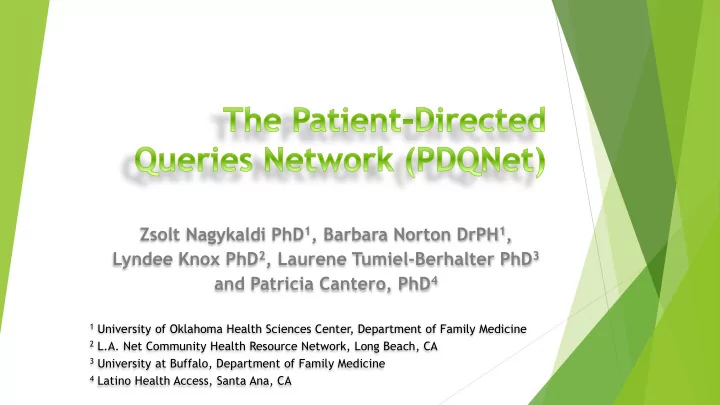

Zsolt Nagykaldi PhD 1 , Barbara Norton DrPH 1 , Lyndee Knox PhD 2 , Laurene Tumiel-Berhalter PhD 3 and Patricia Cantero, PhD 4 1 University of Oklahoma Health Sciences Center, Department of Family Medicine 2 L.A. Net Community Health Resource Network, Long Beach, CA 3 University at Buffalo, Department of Family Medicine 4 Latino Health Access, Santa Ana, CA
• No conflicts of interest of any kind • No discussion of off-label use of medications Responding to FOA: Project Funding: Accelerating PCOR and PCORI ME-1403-11937 Methodological Research Research Contract (2014) ($867,328 ) PDQNet is a 3-year methods study that aims to address how patient and community groups, in partnership with academic researchers and Practice-Based Research Networks, can be active participants in setting and prioritizing the research agenda in primary care settings .
Appreciative Inquiry Concept Mapping Organization Inventory Comm. values assessment Literature Review Conceptual value of Key Informant Interviews information (VOI) estimates Stakeholders are better prepared to be Engagement a part of Scan research partnerships Horizon Prioritization Scan Inquiry 2015 2016 2017 PCORI may know better how to leverage community priorities in community-centered primary healthcare research
Oklahoma o Stephens County CHIO (501-c3) o OKPRN (PBRN 501-c3) o OUHSC Primary Care Researchers Buffalo, NY o Patient Voices Network o UNYNet (PBRN) o Univ. of Buffalo Researchers Los Angeles (metro), CA CHIO: County Health Improvement Organization o Latino Health Access (Comm. Org.) PBRN: Practice-Based Research Network o L.A. Net (community PBRN) UNYNet: Upstate New York PBRN o L.A. Net Applied Research Consortium L.A. Net: Los Angeles Community Health PBRN
OUFMC researchers in Oklahoma City, OK University at Buffalo L.A. Net researchers in researchers in Buffalo, Los Angeles, CA NY Core Community Research Community Research N=17 Leadership Team Partner Organizations Team N=10 (PBRNs, PEOs, CBOs) UNYNet L.A. Net PBRN PBRN Patient Latino Voices Healthy Network Access OKPRN PBRN Pathways for a OTHER PATIENT Healthier Stephens OR COMMUNITY OTHER PATIENT County (CHIO) GROUPS OR COMMUNITY GROUPS Community Research Partner Organizations PBRNs: Practice-Based Research Networks PEOs: Patient-Engaged Organizations CBOs: Community-Based Organizations CHIO: County Health Improvement Organization
“What specific action can bring community input and voices into the study of health and healthcare improvement?” Brainstorming Ideas STEP 1 8 groups: 103 ideas based on focus prompt Large Groups & On-line Sorting Ideas into 8 clusters of concepts STEP 2 Concepts Expert Team Rating the Ideas 3 rating scales STEP 3 feasibility, importance, relevance Large Groups & On-line CS Global Max TM Analyzing the Data STEP 4 software and Creating Maps Expert Team Interpreting Outcomes STEP 5 3 interpretation groups a creative stage Large Groups
Cluster Final Concept Labels Accountability 1 Community-Informed 2 Competencies Community Awareness 3 Communication 4 Respect and Trust 5 Community-driven 6 Engagement Collaboration 7 Working in and Through 8 the Community
1 = not important ; 2 = somewhat important ; 3 = moderately important ; 4 = very important ; and 5 = extremely important
“Communicate simply and clearly, in plain language,…” Go-Zone for Action 4.26 77 99 3 28 85 3.57 83 5 8 2 Impact 1 17 86 2.79 3.83 2.78 4.52 Importance 1 = not important ; 2 = somewhat important ; 3 = moderately important ; 4 = very important ; and 5 = extremely important
In the emerging conceptual INTANGIBLE model, community actors push out their health-related These clusters represent problems, priorities, or Culture a collection of general questions to receptive & Values community capacity building processes , researchers and funders who Community-informed important to readiness Accountability actively pull them in, such Competencies for research-engagement that problems identified by the community set the (Health) Communication Respect and Trust agenda for researchers. Collaboration Push RESEARCHER- Pull & Exchange COMMUNITY- Strategies CONTROLLED CONTROLLED Strategies Community-driven Community engagement Awareness Community High-rated clusters under these Animation* themes represent a set of actionable principles critical to building an interface between Working through the Community communities and researchers in setting research priorities * Community Animation: help bringing forth innate resources and abilities TANGIBLE present in the community
PARTNER: Work with PARTNER: Work with others to take action or researchers to address advocate for change highest priority needs (when appropriate) (when appropriate) DECIDE: Select from top 3- 5 problems/needs based on evidence and community EVALUATE: Gather values (Value of Information) evidence on top 3-5 problems/needs RANK: Order problems (collaborating with and needs based on researchers) community values (initial ranking to identify top 3-5) IDENTIFY: ASSESS: Brainstorm to Establish the core values of the create a list of pressing community problems and needs Starting Point/Conditions: 1) Pre-existing relationship with research partner(s) 2) Capacity to conduct priority-setting activities
Uses a Promotor or Community Health Worker model as the driving force for the organization. Health “as a state of complete physical, mental and social well- being.” (WHO, 1948) Assist in improving the health of low-income people...through the full participation in decisions affecting their health.
Brainstorming Ideas Sorting Ideas into Concepts Ideal Rating the Ideas feasibility, importance, Challenging relevance Analyzing the Data and Creating Maps Interpreting Outcomes A creative stage
Making research WORK for the community ... already! Identifying effective methods for engagement: Translating research questions and data gathered in English & Spanish Translating (explaining) research methods to staff Translation Stakeholders are better prepared to be Translating (interpreting) message to research team a part of research partnerships Lessons from process: Include a diverse team of experts Next Steps Budget adequately for future research
Funding: ME-1403-11937
Recommend
More recommend